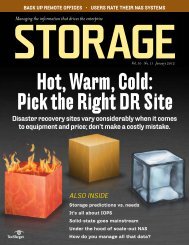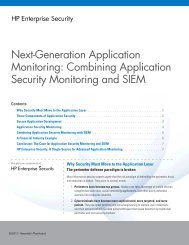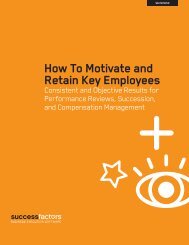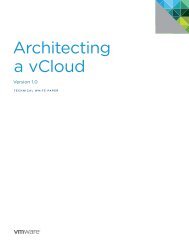Integrated, Real-Time Decision Making: - Bitpipe
Integrated, Real-Time Decision Making: - Bitpipe
Integrated, Real-Time Decision Making: - Bitpipe
Create successful ePaper yourself
Turn your PDF publications into a flip-book with our unique Google optimized e-Paper software.
At the core of the HIAL is the TELUS Health Integration Platform, the foundation of many TELUSofferings, which is based on the webMethods Enterprise Service Bus (ESB). The HealthIntegration Platform brings together data from virtually any system, including care-providerregistries, domain-specific clinical data repositories, hospital-based clinical informationsystems, and pharmacy practice systems.To access the DIS data, healthcare providers can use a portal, such as the Care Provider PortalTELUS developed using webMethods technology. They can then update the EHR data in realtime, so that the next provider has the latest, most accurate patient record. Providers can alsoaccess the same data through their EMRs connected to the HIAL.Benefits of the system include:• Delivering complete patient data at the point of care• Saving lives by reducing errors and keeping providers informed• Reducing costs by automating processes and leveraging existing technologies• Meeting HL7v3 standards for electronic health information exchange• Providing the ability to easily scale to meet the increased demand for EHRsWorking Directly with Doctors and Healthcare ProfessionalsThe Children’s Hospital of Eastern Ontario (CHEO) is an academic pediatric hospital affiliatedwith the University of Ottawa, with a mandate for care, research and teaching. Over the pastthirty years, CHEO has established itself as a world-class academic health sciences centerproviding leading-edge treatment, diagnostic and laboratory services for children and youthaged 0 to 18 years.Using the webMethods suite,CHEO is now able to aggregateall (7-10 or more) alarms foreach patient and process themagainst clinical markers definedby the senior staff.Pediatric hospitals like CHEO face a unique challenge in critical care. As a noted child careexpert puts it, “the status of children under critical care changes at a much more rapid ratethan it does in adults.” Therefore, the many monitoring devices used for children havethresholds set to provide staff with alerts that must be addressed individually. Because eachalert requires a dispatch, the frequency of alarms dictates that, with a given nursing staff, onlya low fixed number of children can be cared for. However, if the staff could understand eachpatient’s total alarm picture from the multiple monitors, they could better understand whichcase needed urgent attention and which case was routine.Using the webMethods suite, CHEO is now able to aggregate all (7-10 or more) alarms foreach patient and process them against clinical markers defined by the senior staff. Staff andcaregivers can efficiently and effectively monitor more patients, provide better care, and helpensure better patient outcomes. The staff has now evolved from reacting to anticipating astrending markers are met or exceeded.8WHITE PAPER | <strong>Real</strong>-<strong>Time</strong> Integration
















